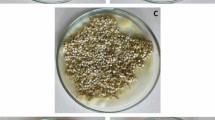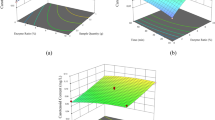Abstract
Germinated legumes are highly nutritious food especially for their enhanced iron bioavailability primarily because of reduction of phytates and increase in ascorbic acid with an advancement of germination period. Length of germination time followed by different heat treatments affect the nutritive value of leguminous sprouts. To optimize germination time and heat treatments for enhanced availability of iron from leguminous sprouts, three legumes namely, mungbean, chickpea and cowpea were germinated for three time periods followed by cooking of sprouts by two cooking methods ie. pressure cooking and microwaving. Optimized germination time for mungbean was 12, 16 and 20 h; 36, 48 and 60 h for chickpea and 16, 20 and 24 h for cowpea. Germination process increased ascorbic acid significantly in all the three legumes, the values being 8.24 to 8.87 mg/100 g in mungbean, 9.34 to 9.85 mg/100 g in chickpea and 9.12 to 9.68 mg/100 g in cowpea. Soaking and germination significantly reduced the phytin phosphorus in all the three legumes, the percent reduction being 5.3 to 16.1% during soaking and 25.7 to 46.4% during germination. The reduction in phytin phosphorus after pressure cooking was 9.6% in mungbean, 18.4% in chickpea and 6.1% in cowpea. The corresponding values during microwaving were 8.4, 19.7 and 4.5%. Mineral bioavailability as predicted by phytate:iron enhanced significantly with an increase in germination time. Further reduction i.e. 0.9 to 16.3% was observed in three legumes after the two heat treatments. The study concluded that the longer germination periods ie. 20 h for mungbean, 60 h for chickpea and 24 h for cowpea followed by pressure cooking for optimized time were suitable in terms of better iron availability.
Similar content being viewed by others
References
AOAC (1980) Official Methods of Analysis (13th edn). Association of Official Analytical Chemists, Washington DC, USA
Bains K, Barakoti L, Aggarwal R (2006) Phytate: Iron, Phytate: Zinc and Phytate X Calcium: Zinc molar ratios of products developed from mungbean. Env and Ecol 25:25–28
Barakoti L, Bains K (2007) Effect of household processing on the in vitro bioavailability of mungbean (Vigna radiata). Fd Nutr Bull 28:18–22
Colmenares De Ruiz AS, Bressani R (1990) Effect of germination on the chemical composition and nutritive value of amaranth grain. Cereal Chem 67:519–22
Duhan A, Khetrpaul N, Bishnoi S (2000) Optimum domestic processing and cooking methods for reducing polyphenolic antinutrient content of pigeon pea. Nutr Hlth 13:227–34
el-Adawy TA (2002) Nutritional composition and antinutritional factors of chickpeas (Cicer arietinum L.) undergoing different cooking methods and germination. Plant Foods Hum Nutr 57:83–87
Forbes RM, Parker HM, Erdman JWJ (1984) Effects of dietary phytates, calcium and magnesium levels on zinc bioavailability of rats. J Nutr 114:1421–24
Fordyce EJ, Forbes RM, Robbins KR, Erdman JW (1987) Phytate X Calcium: Zinc molar ratios: Are they predictive of zinc bioavailability? J Food Sci 52:440–42
Gupta DN, Gaikwad V, Satwant PS (2005) Effect of processing on neurotoxin content and vitamin C during germination in the grains of L.Sativus. The Ind J Nutr Dietet 42:367–72
Haug W, Lantzch HJ (1983) Sensitive method for the rapid determination of phytates in cereals and cereal products. J Sci Food Agri 34:1426–26
Lee CK, Karunanithy R (1990) Effects of germination on chemical composition of glycine and phaseolus beans. J Sci Food Agric 51:437–45
Malleshi NG, Klopfenstein CF (1996) Proximate composition, amino acid and vitamin contents of malted chickpea, mungbean and their seed coats. J Food Sci Technol 33:479–82
Mbithi M, Van Camp J, Rodriuez R, Huyghebaert A (2001) Effects of sprouting on nutrient and antinutrient composition of kidneybeans. Eur Food Res Technol 212:188–91
Morris ER, Ellis R (1980) Effect of dietary phytate:zinc molar ratios on growth and bone response of rats fed semipurified diets. J Nutr 110:1037–40
Mulimani VH, Nanda S, Kadi, Thippeswamy S (2003) Effect of processing on phytic acid content in different redgram(Cajanus cajan L)varieties. J Food Sci Technol 40:371–73
Oberleas A, Harland BF (1981) Phytate content of foods. Effect on dietary zinc bioavailability. J Am Dietet Assoc 79:433–35
Riddoch CH, Mills CF, Duthie GG (1998) An evaluation of germinating beans as a source of vitamin C in refugee foods. Eur J Clin Nutr 52:115–18
Rincon F, Ros G, Collins JL (1993) Mineral loss in cowpea (vigna unguiculata (L.) Walp) by pressure heating in water. J Food Sci 58:856–58
Savelkoul FH, Vander Poel AF, Tamminga S (1992) The presence and inactivation of trypsin inhibitors, tannins, lectins and amylase inhibitors in legume seeds during germination A review. Plant Foods for Human Nutrition 42:71–85
Sinha R, Kawatra A, Sehgal S (2005) Saponin content and trypsin inhibitor activity of cowpea: varietal differences and effects of home processing and cooking methods. J Food Sci Technol 42:182–85
Stephens J M 2003. Bean sprouts- Phaseolus aureus R. and Glycine max. Series no. HS557, Horticulture Sciences Department, Florida Cooperative Extension Service, Institute of Food Agricultural Sciences, University of Florida, USA. p 1–2.
Trugo LC, Donangele CM, Trugo NM, Bach Knudsen KE (2000) Effect oh heat treatment on nutritional quality of germinated legume seeds. J Agric Food Chem 48:2082–86
Urbano G, Jurado ML, Aranda C, Vilchez A, Porres JM (2006) Evaluation of zinc and magnesium bioavailability from pea (Pisum Sativum L.) sprouts. Effect of illumination and different germination periods. Int J Food Sci Tech 41:618–26
Ziegler P (1995) Carbohydrate degradation during germination. In: Kigel J, Galili G (eds) Seed development and germination. Marcel Dekker Inc, New York, pp 447–74
Author information
Authors and Affiliations
Corresponding author
Rights and permissions
About this article
Cite this article
Bains, K., Uppal, V. & Kaur, H. Optimization of germination time and heat treatments for enhanced availability of minerals from leguminous sprouts. J Food Sci Technol 51, 1016–1020 (2014). https://doi.org/10.1007/s13197-011-0582-y
Revised:
Accepted:
Published:
Issue Date:
DOI: https://doi.org/10.1007/s13197-011-0582-y




